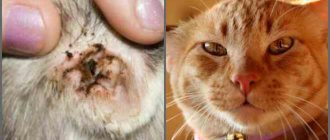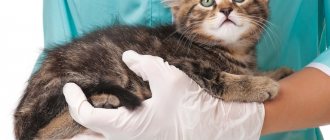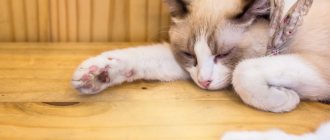The danger of cat bites and scratches for humans
Cats, both outdoor and indoor, can be carriers of various infections that are dangerous to human health. Cat bites and scratches are one of the main ways of transmitting such infections. The saliva and paws of these cute animals may contain pathogenic bacteria that cause various diseases.
Bite and scratch hazards:
- pain, soft tissue damage, bleeding;
- injury to joints, tendons and muscle fibers;
- penetration of bacteria and viruses into the human blood, causing inflammation and dangerous diseases.
Sources of bacteria and viruses in cats:
- Through flea bites and eating their parasites;
- Through rodents and birds that the “tigress” hunts;
- Contact with soil, debris, excrement.
- Through food (spoiled, infested with parasites, waste)
Signs of infection in an animal
A person can become infected with rabies only through contact with a sick animal. The most common cause of infection is the bites of stray animals: dogs and cats. They, in turn, can catch the virus from wild animals.
Most often, a person becomes infected with rabies after contact with a sick stray animal.
An infected cat, as rabies progresses, behaves aggressively.
The cause of human infection can be not only the bite of a cat with rabies, but also its licking of areas of the body with microdamages and wounds. Saliva can also transmit infection, and therefore it is important to know what a sick animal looks like in order to avoid close contact with it.
Signs of rabies do not always manifest themselves in the form of open aggression. Initially, the cat may behave as usual and show affection.
Already in the later stages of the disease, the following symptoms are observed:
- aggressiveness;
- foam at the mouth associated with increased salivation;
- muscle cramps;
- refusal of food;
- fear of water;
- loss of the instinct of self-preservation, lack of fear;
- ignoring pain;
- general painful appearance.
A sick animal dies on average 5 to 12 days from the moment of infection.
What can you get infected from cat scratches?
More than 90% of cats can carry bacteria that are dangerous to humans. The sharp teeth and claws of our beloved cats dig into the human body like spears, increasing the risk of viruses and infections leaving the wound and getting into the blood.
Let's look at some of them.
- Pasteurellosis.
A rather rare infection, transmitted both through scratches and through an animal bite. Symptoms appear within 3-6 hours after injury. The causative agent of the disease is Pasteurella bacteria, transmitted from a sick animal.
Symptoms in humans: Swelling and redness in the wound area; The appearance of bubbles with liquid around a scratch or bite; Fever, weakness, chills, sweating; The appearance of cough with phlegm and chest pain; Pulmonary edema.
Animal symptoms:
- increased body temperature;
- lack of appetite;
- increased heart rate and breathing;
- difficulty breathing, purulent nasal discharge.
- Toxoplasmosis.
This parasitic disease, which has found refuge in the intestines of a cat and after infecting a person, is transmitted by airborne droplets to another person. For many, infection with these microscopic parasites goes unnoticed, but their presence can cause serious consequences.
IMPORTANT! Pregnant women and people with weakened immune systems are at risk.
Consequences of the disease:
- can cause miscarriage or stillbirth;
- in case of infection during pregnancy, there is a risk of “rewarding” the baby with parasites while still in the womb;
- influence on the human nervous system and behavior: inhibition, risk-taking, anxiety, doubt, neuroticism.
Symptoms in humans:
- Increase in body temperature to 38ﹾC;
- Yellowing of the eyes;
- General intoxication of the body;
- Nausea, vomiting, diarrhea;
- Enlarged lymph nodes;
- Headache, weakness, fatigue;
- Muscle pain, decreased tone.
The danger is that there may be no symptoms.
Animals may not outwardly manifest the disease and its presence can only be detected by analyzing feces. In the acute course of the disease, the symptoms in cats are similar to those in humans (fever, nausea, vomiting, diarrhea), and tearing from the eyes and nose also increases.
But don’t be scared and kick your cute cats out of the house. As a rule, pets are surrounded by attention, care and good nutrition. Any deviation in the animal’s behavior and well-being should be responded to in a timely manner, and infection should be prevented.
Can a vaccinated cat get rabies?
The rabies vaccine does not completely guarantee that the animal will not get sick. If during vaccination the cat was infected with worms, then there remains a risk that the vaccination will not give results.
Symptoms of the disease appear within 2 weeks. The presence of the rabies virus in the body during vaccination is the cause of the disease.
Factors that influence the formation of immunity to the virus:
- age of the cat;
- exhaustion;
- stress;
- chronic diseases;
- multiple births.
Effective means for wound healing.
Even minor cat scratches are accompanied by itching, burning, pain and take a long time to heal. Relieving inflammation and discomfort is the natural desire of a person who has become a victim of a furry predator. But the following tools will help you cope with this task perfectly.
The drug Miramistin.
The main active ingredient is myristic acid. The product is perfect for preventing suppuration and complications of wounds.
Properties: antiseptic. Causes the death of microorganisms, accelerates wound healing, stimulates the immune system.
Application: prevention of suppuration, treatment of purulent wounds. It must be applied to the wound immediately after rinsing with water.
Emu Fat
Emu is an Australian ostrich. Oil from poultry fat is used to treat wounds.
Properties: antioxidant. Relieves pain in the wound area, has a healing effect, and protects the skin from replenishment.
Application: externally, after treating a wound.
Compatible in use with other drugs.
IMPORTANT! There are no side effects.
Using Levomekol ointment.
A budget product that contains an antibiotic.
Properties: antibacterial, antimicrobial. Stimulates the process of tissue regeneration, penetrates deep into tissues, suppresses the inflammatory process, removes purulent discharge, eliminates swelling.
Application: externally - apply a thin layer to the wound area after treatment with an antiseptic at night. Cover the wound site with a gauze bandage. Change the dressing – once a day. Used in the first phase of the wound process. The ointment is suitable even for newborns for scratches from a playful cat. Do not use with other ointments for external use.
First aid
In any case, if a cat bites or scratches, you need to immediately treat the wound. This will reduce the risk of complications.
- Wash the area of the bite or scratch with soap and water, preferably household soap. It will sting, but the cat’s saliva and possible bacteria will be washed away.
- Treat the wound with 3% hydrogen peroxide or 0.05% chlorhexidine solution.
- Disinfect the edges of the wound with iodine, brilliant green or alcohol. Try not to get into the wound itself, otherwise a burn may occur.
- Apply a gauze bandage to the treated area.
After some time, when the bleeding has completely stopped and the wound has dried, you can apply a bandage with antibacterial ointment. This will allow healing to occur faster and reduce the risk of re-injury to the wound. The following are considered effective:
- Miramistin. Prevents inflammation and wound suppuration.
- Rescuer. The balm relieves pain and accelerates scarring of the wound.
- Solcoseryl. It heals scratches well and prevents the formation of scars, but it can only be applied to a dried wound. If there are signs of inflammation and suppuration, do not use.
- Levomekol. Typically used when pus forms. If the injury occurred far from the city, where there is no opportunity to get medical help, and suppuration has begun, you can use this ointment.
Important! All medications must be used strictly according to the instructions, taking into account age, contraindications and other points. Find out also - How to rid a kitten of the habit of biting and scratching its owners.
When is a doctor needed?
There is no need to self-medicate and let everything take its course if there is a danger that the cat could be a carrier of an infection, virus or parasites.
What to pay attention to:
- if a pet scratches or bites, then it is necessary to monitor its behavior, whether it differs from everyday life, whether there is any discharge from the nose, mouth and eyes, illogical behavior, excessive aggression that is not typical for it;
- If the animal was a street animal, unfamiliar, the likelihood that it could be a carrier of infections dangerous to humans increases significantly, especially with aggressive behavior and excessive salivation.
- the presence of symptoms, such as: inflammation or swelling in the wound area, the appearance of bubbles with liquid, increased body temperature, malaise, sweating, convulsions.
- the wound is close to vital organs: neck, face, eyes or joints.
In these cases, contacting a doctor will be timely, will help avoid complications and prescribe the right treatment.
Causes for concern
Cats can quite often scratch or bite their owners severely during play. This becomes almost a habitual part of communication with your pet. Most often the arms and fingers are affected, less often the legs and torso.
You should pay closer attention to the scratch if:
- scratched by a street cat;
- the scratch was caused by an unvaccinated cat;
- bleeding does not stop for more than 10 minutes;
- the wound site hurts, blood, pus, and ichor are released from it;
- bubbles appear in the area of scratches;
- the skin around the scratch is swollen and red;
- temperature rises;
- weakness appears;
- lymph nodes enlarge.
How long does it take for scratches to heal without treatment?
Any game or proud disposition of domestic cats ends for their owners with scratched arms, legs, and sometimes even the face. And everyone has noticed that scratches take a long time to heal, spoil the appearance and irritate the skin.
Reasons for long skin recovery after a scratch:
- a cat's claw penetrates deeply into a person, the wound is closed and torn;
- dirt and bacteria that lived on the animal’s claws accumulate in the wound;
- the healing process increases, since it is necessary not only to grow new tissue, but also to get rid of pathogens.
With good immunity and not a deep wound, the scratch will heal in 3-7 days. Neglecting wound treatment can cause complications, provoke an inflammatory process, the introduction of other infections into the wound, and its suppuration. In this case, the healing process will increase and this period will depend on the degree of complication and its consequences.











